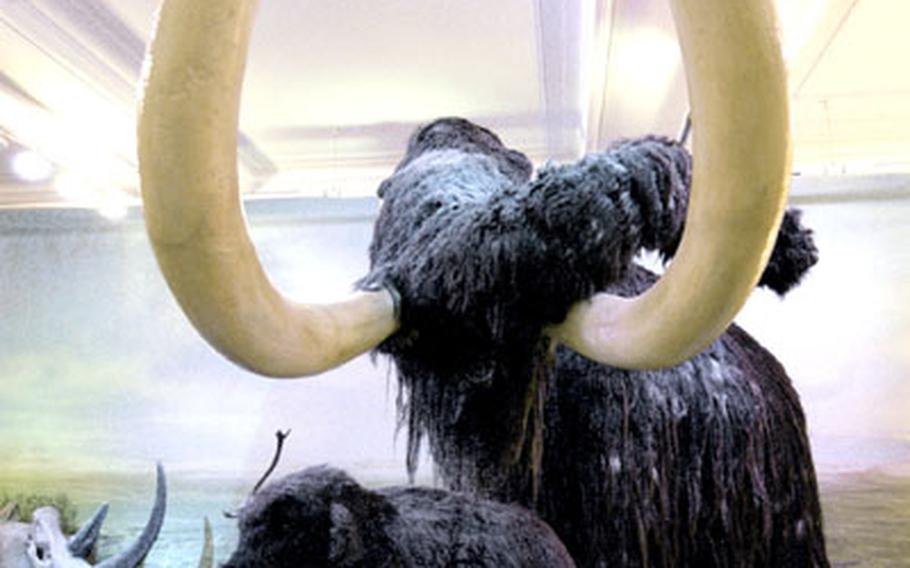
Models of a mammoth and its youngster at the Hessisches Landesmuseum in Darmstadt. (Michael Abrams / S&S)
The thing I remember most about my first visit to the Hesse State Museum in Darmstadt, Germany, was the a coat of fur in a display case on a wall. It was the skin of the last wolf in Hesse, shot near Lorsch in 1841.
That visit was decades ago, but for some reason that wolf has always stuck in my mind.
It is not like there are not plenty of other things to see at the Hessisches Landesmuseum, as it is called in German. Then and now, the museum is a conglomeration of natural history and art exhibits first collected by the grand dukes of Hesse in the 17th century.
The museum got its start when, in 1820, Grand Duke Ludewig I of Hesse endowed his private collection to the state. Over the next 18 decades, the collecting has never stopped.
While this makes for quite a hodgepodge of things to see, it ensures there is something for everybody at the museum.
Children are enthralled by the whale skeleton hanging from the ceiling of the ground floor zoology exhibit, and by the giant mastodons in the paleontology exhibit on the floor above.
Grown-ups will probably be drawn more to the art exhibits spread over the four floors of the museum, and all will likely be intrigued by the evolution- of-man display with its lifelike models of what prehistoric man might have looked like.
The Landesmuseum is especially proud of its collection of fossils from the nearby Messel Pit Fossil Site, which is on the World Heritage List, and is one of the richest sites for fossils from the Eocene period.
Just as a sampling of the variety available, here are some of the museums collections: art nouveau and art deco furniture; jewelry and porcelain; glass painting from 900-1900; cork models of ancient Rome and prehistoric and early history of Europe, all in the basement.
Along with zoology, there is art from 1250 to 1550, medieval crafts and musical and physics instruments on the ground floor.
The second floor has geology, mineralogy and paleontology exhibits, while the third floor has 19th century art, works by German artist Joseph Beuys and art from 1550 to 1800. In January or February a new collection of 20th century sculptures is due to open.
The top floor contains the graphics collection and room for temporary exhibits.
But that’s not all. In 1984 a new wing was added to hold the museum’s 20th-century art. Only 20 years old, it is soon to be torn down to make room for a new, bigger wing to hold its ever-growing collection.
There are few museums in Germany that still have an interdisciplinary collection like the Hessisches Landesmuseum, where you can learn about the history of art, culture and nature all in one stop.
And the only one where you can see the last wolf in Hesse.
On the QT ...
Directions: The Landesmuseum is in downtown Darmstadt, north of the Schloss (palace), just outside of the pedestrian zone at Friedensplatz 1. There is no free parking downtown on weekdays. The entrance to the Schloss parking garage is right in front of the museum. It costs 1.50 euros per hour, but is closed Sundays. The closest parking open Sundays is Luisenplatz, also 1.50 euros per hour. On bus lines F, H, K and L and streetcar lines 3 and 9, get off at Schloss; get off at Luisenplatz for streetcar lines 4, 6, 7 and 8.
Hours: 10 a.m. to 5 p.m. on Tuesdays, and Thursday to Saturday; 10 a.m. to 8 p.m. on Wednesdays; and 11 a.m. to 5 p.m. on Sundays and German holidays. Museum closed Mondays and Dec. 24, 25, 31 and Jan. 1, 2005.
Cost: Admission is 2.50 euros for adults, 1 euro for children, and 5 euros for a family ticket. Free admission daily after 4 p.m. Sometimes extra admission is charged for special temporary exhibits.
Food: There is a café in the foyer that offers drinks, cakes and snacks. You don’t have to pay museum admission to enter.
Information: The museum’s German- language Web site is www.hlmd.de.
— Michael Abrams